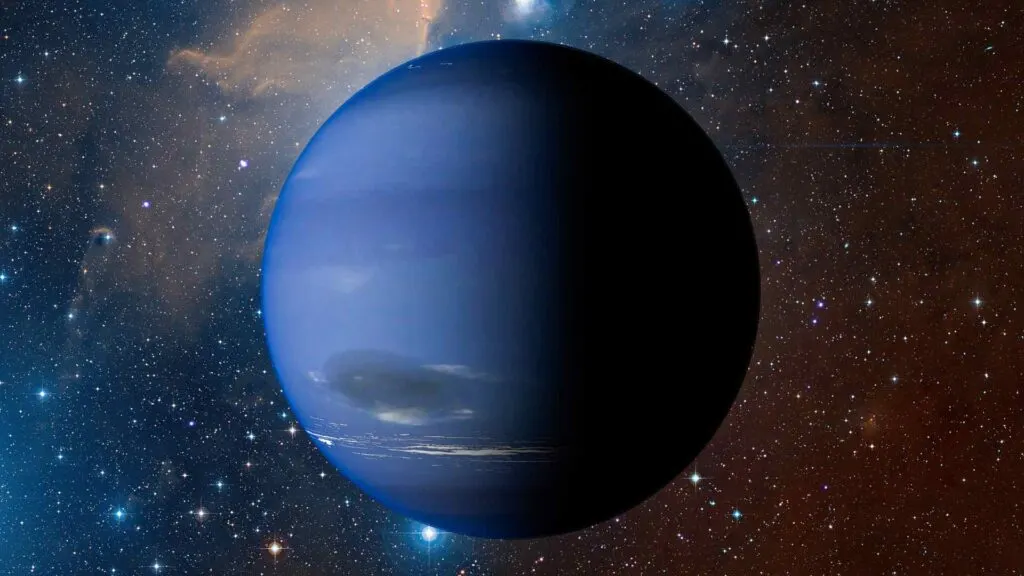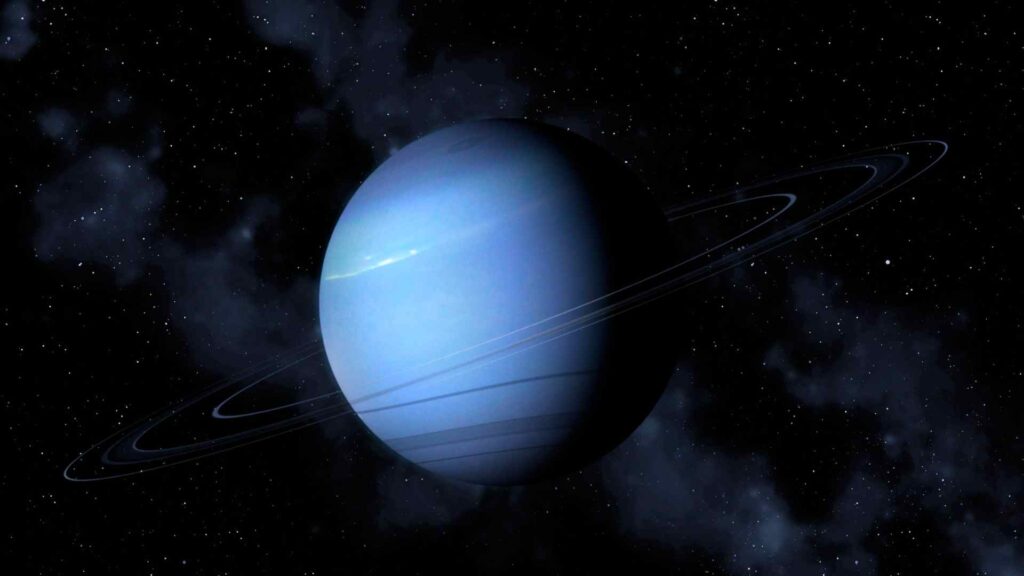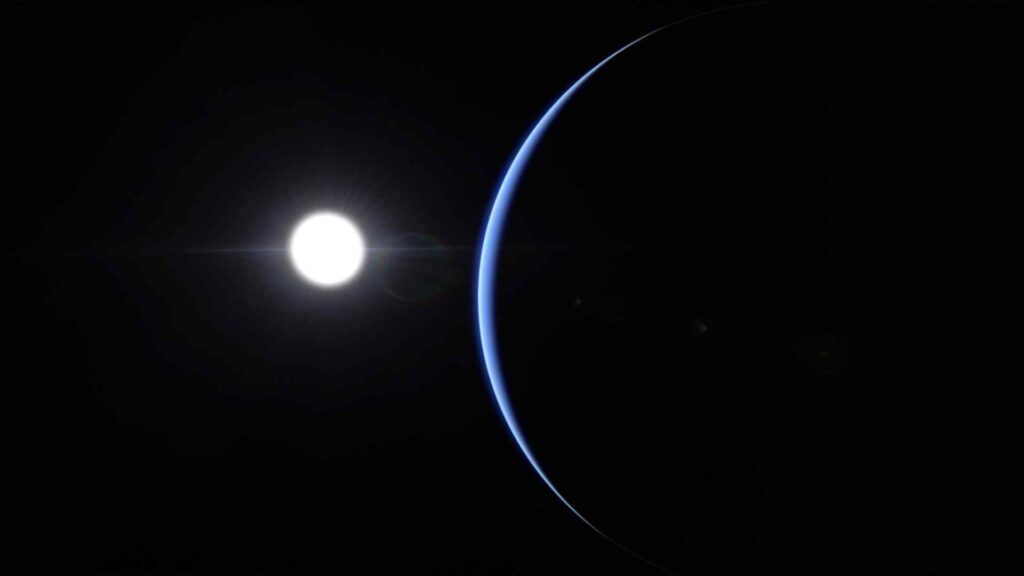Neptune, our solar system’s icy, windy, and farthest major planet, holds many mysteries. With its swirling storms and vibrant blue hue, Neptune captivates astronomers and space lovers alike.
Dive into these incredible fun facts about Neptune, exploring everything from its discovery to its unique features and more. Ready to be amazed?
Neptune’s Discovery and Naming
- Neptune was discovered on September 23, 1846, by Johann Galle and Heinrich d’Arrest.
- The discovery was actually predicted by mathematical calculations rather than through direct observation.
- French mathematician Urbain Le Verrier predicted Neptune’s position due to irregularities in Uranus’s orbit.
- Neptune is named after the Roman god of the sea, matching its blue, ocean-like appearance.
- Galileo first observed Neptune in 1612, mistaking it for a star due to its slow movement.
- Neptune was the first planet discovered by math rather than by a telescope.
- Several countries, including Britain and France, claimed the discovery of Neptune, leading to some debate.
- Neptune’s symbol is a trident, representing the Roman god Neptune’s weapon.
- The search for Neptune arose because Uranus didn’t follow its predicted path.
- Neptune and Uranus are sometimes called “twin planets” due to their similar sizes and compositions.
- Although it was discovered in 1846, Neptune completed its first full orbit around the Sun in 2011.
- Its name was initially debated, with suggestions including “Janus” and “Oceanus.”
- Neptune’s nickname, “the blue planet,” comes from its deep azure color, different from Earth’s.
- The official naming of Neptune was influenced by both German and French scientists.
- Neptune’s discovery was monumental, marking the first expansion of our solar system beyond what was visible to the naked eye.

Neptune’s Orbit and Distance from the Sun
- Neptune orbits the Sun at an average distance of 4.5 billion kilometers (2.8 billion miles).
- It takes Neptune about 165 Earth years to complete one orbit around the Sun.
- Seasons on Neptune last for over 40 Earth years due to its long orbit.
- Neptune’s elliptical orbit means its distance from the Sun varies significantly.
- Due to its distance, sunlight on Neptune is 900 times weaker than on Earth.
- One Neptunian day lasts only about 16 hours, much shorter than an Earth day.
- Neptune’s axis tilt is 28.32 degrees, similar to Earth’s, giving it seasonal variations.
- Neptune is currently the most distant major planet in our solar system since Pluto’s reclassification.
- Its orbit lies entirely outside the Kuiper Belt, a region of icy bodies.
- Despite being far from the Sun, Neptune receives solar energy that fuels dynamic weather.
- The planet’s orbital path has a slight inclination of 1.77 degrees relative to Earth.
- Neptune has a unique location in the solar system, positioned between the gas giants and the Kuiper Belt.
- Its orbit is influenced by the gravitational pull of nearby planets, especially Uranus.
- Neptune’s position also helps shield the inner planets from incoming icy bodies.
- Unlike Earth, Neptune’s distance from the Sun means its atmosphere is extremely cold.
Neptune’s Size, Mass, and Composition
- Neptune has a diameter of about 49,244 kilometers (30,598 miles).
- It’s nearly four times the width of Earth and 17 times more massive.
- Despite its mass, Neptune is less dense than Earth due to its gaseous composition.
- Its atmosphere is made mostly of hydrogen, helium, and methane.
- Neptune has a rocky core surrounded by icy water, ammonia, and methane layers.
- Methane in Neptune’s upper atmosphere gives it a blue color by absorbing red light.
- Neptune’s gravity is about 1.14 times that of Earth, meaning a 100-pound person would weigh 114 pounds on Neptune.
- The planet’s core temperature is estimated to be around 5,100 Kelvin (4,800 °C).
- Its thick atmosphere has multiple layers with varying densities and temperatures.
- Neptune’s mass places it among the “ice giants,” a category alongside Uranus.
- Neptune’s density is 1.64 grams per cubic centimeter, much less dense than rocky planets.
- Unlike Jupiter and Saturn, Neptune lacks a thick hydrogen and helium outer layer.
- The ice in Neptune’s composition consists of materials like water, ammonia, and methane.
- Its layered composition resembles Uranus’s, with a hot, icy mantle surrounding the core.
- Scientists believe Neptune’s core is as hot as the surface of the Sun.

Neptune’s Atmosphere and Weather Patterns
- Neptune has the fastest winds in the solar system, reaching speeds of over 1,200 mph.
- Its atmosphere features large storms, including the Great Dark Spot, similar to Jupiter’s Great Red Spot.
- Neptune’s storms can span thousands of kilometers and last for years.
- The planet’s upper atmosphere shows varying cloud bands created by high-speed winds.
- The methane haze high in Neptune’s atmosphere contributes to its blue color.
- Unlike Earth, Neptune’s storms and winds intensify as you move higher in the atmosphere.
- Neptune’s dynamic weather is driven by internal heat rather than sunlight.
- The planet releases more than twice as much energy as it receives from the Sun.
- In 1989, the Voyager 2 spacecraft captured images of a massive storm called the Great Dark Spot.
- Unlike storms on Earth, Neptune’s storms can shrink, disappear, and reappear quickly.
- Neptune has bright, wispy clouds, mostly composed of methane ice crystals.
- Its atmosphere has cold temperatures, reaching as low as -218 °C (-360 °F).
- High-altitude cirrus clouds drift across Neptune’s sky, some casting shadows on lower clouds.
- The gas planet’s atmosphere shows seasonal variations, though they’re slow to change.
- Neptune’s southern hemisphere has been observed to warm up in its long summer season.
Neptune’s Moons and Rings
- Neptune has 14 known moons, the largest being Triton.
- Triton orbits Neptune in a retrograde direction, opposite to the planet’s rotation.
- Triton has geysers that spew nitrogen gas, hinting at potential subsurface warmth.
- Neptune’s other moons are much smaller, with irregular shapes and orbits.
- The planet has five main rings, named Galle, Le Verrier, Lassell, Arago, and Adams.
- These rings are faint and primarily composed of dust particles and ice.
- Triton is considered a captured object from the Kuiper Belt due to its unusual orbit.
- Neptune’s moon Proteus is among the darkest objects in the solar system.
- Neptune’s rings contain clumps and arcs, areas where dust and ice concentrate.
- The outer ring, Adams, has noticeable arcs named Liberty, Equality, and Fraternity.
- Triton, Neptune’s largest moon, is geologically active with a thin nitrogen atmosphere.
- The existence of Neptune’s rings was confirmed in 1984 by stellar occultation studies.
- Nereid, Neptune’s third-largest moon, has one of the most eccentric orbits in the solar system.
- The rings of Neptune are constantly shifting and are thought to be relatively young.
- Triton’s geysers may be powered by seasonal heating, unlike anything seen on Earth’s moon.

Neptune in Pop Culture and Astrology
- In astrology, Neptune rules over dreams, intuition, and the subconscious.
- The discovery of Neptune in 1846 was followed by advances in psychology and understanding the mind.
- Neptune represents the mystical and spiritual in astrology, connected with imagination.
- Its influence in horoscopes symbolizes illusion, inspiration, and empathy.
- Neptune has been a key symbol in works of literature, symbolizing the mysterious and unknown.
- Many sci-fi books, films, and shows feature Neptune as a mysterious outer world.
- Neptune is often portrayed as the “mysterious neighbor” due to its distance and opacity.
- The Roman god Neptune is often depicted with a trident, just like the planet’s astronomical symbol.
- Neptune’s vivid blue color has inspired artists and writers as a symbol of mystery.
- Video games and animated series frequently reference Neptune as a water-rich world.
- Many fictional stories depict Neptune as a portal or gateway to other realms.
- Neptune’s discovery sparked philosophical reflections on unseen forces in the universe.
- Some New Age beliefs associate Neptune with dreams and otherworldly visions.
- Neptune’s energy in astrology is seen as creative but also potentially confusing.
- Neptune’s astrological influence is also linked to deception or seeing beyond illusions.
- Modern horoscopes associate Neptune with inspiration, psychic energy, and art.
Bonus Section: Neptune Puns and Jokes
- “What did Neptune say to Saturn? ‘I’m blue without you!'”
- “Neptune’s storms are really ‘out of this whirl’!”
- “Why did Neptune break up with its moon? It needed some ‘space.’”
- “Neptune’s rings may be faint, but they’re definitely in orbit!”
- “Feeling blue? Just look at Neptune!”
- “Did you hear Neptune’s weather report? ‘Windy with a chance of methane rain.’”
- “Neptune is a real gas giant — it’s full of hot air (and cold too!).”
- “What’s Neptune’s favorite music? The ‘blues’!”
- “Neptune asked Uranus, ‘Why so blue?’ Uranus replied, ‘It’s just a phase.’”
- “Neptune’s atmosphere is ‘chill’ — literally!”
- “Why is Neptune so far out? Because it loves a little distance!”
- “Neptune’s winds are always in a ‘rush to orbit’!”
- “What did Neptune say during a storm? ‘Hold onto your moons!’”
- “Neptune’s storms never ‘calm down.’”
- “Why don’t other planets invite Neptune to parties? It’s too distant!”
- “Neptune’s colors are ‘cool’ for a reason!”
- “Neptune’s moon Triton is the life of the space ‘party’ — just ask Neptune!”
- “Why did Neptune turn down the Sun? It’s all about ‘cool vibes only.’”
- “Neptune’s ring arcs are always on ‘revolv-ing door’ duty!”
- “What’s Neptune’s favorite dance? The ‘orbit’ shuffle!”
- “Feeling spaced out? Join Neptune!”
- “Did you hear about Neptune’s new job? Storm wrangler!”
- “Neptune always brings the ‘blue hue’ to the solar system!”
- “Neptune told Pluto, ‘It’s okay to feel a little small sometimes.’”
- “Neptune’s rings are exclusive — they’re by invite only!”
- “Why was Neptune a great therapist? It was all about deep reflection!”
- “How does Neptune pay bills? ‘Net’ gains!”
- “Neptune is the ultimate ‘chill’ planet!”
- “Neptune’s mood is always blue-tiful!”
- “Why is Neptune so mysterious? It’s always keeping secrets!”
- “Neptune’s always ‘tide-d’ up with storms!”
- “Neptune: the cool blue planet with a ‘stormy’ personality!”
- “What did Neptune say when it spotted a comet? ‘Don’t orbit my space!’”
- “Neptune’s never lonely — it has 14 loyal moons!”
- “What did Neptune call its intense storm? ‘Hurricane of the century!’”
- “Neptune doesn’t need fame — it’s already out of this world!”
- “Why did Neptune refuse the Sun’s offer? It preferred staying in the cool zone.”
- “Neptune always has ‘blue skies ahead!’”
- “Neptune’s winds? They really blow minds!”
- “Neptune said to Uranus, ‘Let’s make waves in the solar system!’”
- “Why don’t people talk about Neptune’s rings? They’re too spaced out.”
- “Feeling spaced out? Neptune says, ‘Join the club!’”
- “Neptune loves to ‘rock the ring’ with its faint arcs!”
- “What did Neptune say to Earth? ‘You’re too close for comfort!’”
- “Why does Neptune stay cool? It’s all about the distance!”
- “Why don’t Neptune and Mercury get along? Too much heat in the conversation!”
- “Neptune’s always storming up ideas!”
